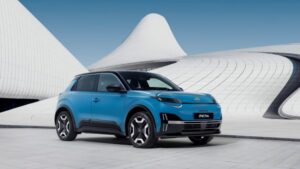Fiat’s E-Ducato faces serious competition in the electric van market – going head-to-head with its Stellantis siblings like the Vauxhall Movano Electric, Citroen E-Relay, and Peugeot E-Boxer. That’s before you even consider the Ford E-Transit and the award-winning Renault Master E-Tech.
The van’s built on foundations that date back to 2006. While Fiat’s added updates over the years, the question remains: can this refreshed model compete with newer rivals?
Design and Interior
The latest E-Ducato gets minor visual updates – mainly a prominent ‘FIAT’ badge surrounded by large grilles that don’t actually need airflow for the electric powertrain.
Beyond that facelift, it’s showing its age.
Inside, you’ll find hard plastics and an old-fashioned dashboard that feels dated compared to the E-Transit or Master. The cabin is spacious though, with room for two passengers on the bench seat and plenty of storage options.
Equipment depends on which trim you choose. The entry-level model comes with a seven-inch screen, DAB radio, climate control, rear parking sensors, and two cupholders.
Step up to the Ducato Primo trim and you get a 10-inch infotainment system with Apple CarPlay and Android Auto, wireless phone charging, and a digital rear-view mirror. There’s also 360-degree parking sensors and blind spot assist.
Even the top Primo spec lacks heated seats and other conveniences you’ll find in competitors.
Battery and Performance
The E-Ducato uses a 275bhp electric motor with 302lb ft of torque – enough power for heavy loads. Its 110kWh battery pack is one of the largest in the sector, beaten only by Mercedes’ 113kWh eSprinter battery.
That huge battery delivers just 235 miles of range – 20 miles less than the Master E-Tech with its smaller 87kWh pack.
Choose the 4.25-tonne model and range extends to 263 miles, but you’re limited to 56mph and face HGV-style regulations.
Charging takes under an hour from 5% to 80% using a 150kW rapid charger. A full charge via a 7.4kW home wallbox stretches beyond 16 hours.
Three driving modes help manage efficiency: Eco limits power to 165bhp, Normal allows 220bhp, and Power unleashes the full 275bhp. Regenerative braking is adjustable, but there’s no one-pedal driving mode.
On the road, the E-Ducato feels its age. The ride is bouncy over rough surfaces, steering feels vague, and there’s noticeable body roll – making it less refined than the smooth E-Transit.
Acceleration is brisk though, even when fully loaded.
Payload and Practicality
This is where things get tricky for the E-Ducato.
The standard 3.5-tonne L3H2 model offers 13 cubic metres of load space but payload is limited to around 710kg due to the heavy battery. That’s significantly behind the E-Transit’s 1,000kg payload and the Master E-Tech’s 1,125kg at the same weight.
The 4.25-tonne variants provide payloads up to 1,460kg and 17 cubic metres of cargo space – but come with complications like mandatory driver training, tachograph installation, annual MOTs from year one, and that 56mph speed limit.
The cargo bay includes LED lighting, steel bulkhead, and load-lashing points, but payload remains compromised compared to class leaders.
Price and Specification
The E-Ducato starts at £49,485 plus VAT for the L3H2 variant – competitive with its Stellantis siblings and undercutting the E-Transit and eSprinter. The Renault Master E-Tech is significantly cheaper though.
All models qualify for the government’s £5,000 plug-in van grant.
Servicing intervals are set at two years or 32,000 miles, with Fiat’s three-year, 100,000-mile warranty.
Verdict
The E-Ducato offers decent range, solid performance, and competitive equipment in Primo trim. But its dated chassis, poor payload at lower weights, and inferior driving dynamics hurt its appeal.
If you prioritize competitive pricing, it might work – but the Master E-Tech beats it on both price and performance. For comfort and refinement, you’ll find better options among more modern rivals.
Fiat E-Ducato 35 L3H2 Specifications:
- Price: £49,485 plus VAT and OTR
- Powertrain: front-motor, front-wheel-drive
- Battery: 110 kWh
- Power: 275bhp
- Torque: 302 lb ft
- Top speed: 81 mph
- 0-62mph: 10 seconds
- Range: 235 miles
- Charging: up to 150 kW





